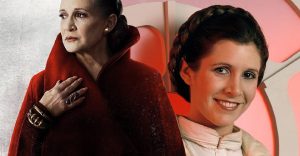Mad Men’s Biggest Movie Inspirations Make The Show Even Better

Mad Men is influenced by a number of classic movies, which add further layers to the show and improve it in the process. Cinema plays a large part in the life of advertising executive and creative director, Donald Draper (Jon Hamm). He is regularly seen to spend days in movie theaters, watching the latest releases in an attempt to keep his own work relevant to the times. There are numerous movie references across all seven seasons of Mad Men, such as when Don and his wife Megan find the movie Rosemary’s Baby disturbing. Their horror is lent added thematic weight by the fact its set in an apartment complex across the street from their own. Not only that, but aspiring movie star Megan becomes an analog for Sharon Tate, the murdered wife of Rosemary’s Baby director Roman Polanski.
One of the most moving scenes in all of Mad Men is when Don Draper takes his son Bobby to a showing of Planet of the Apes. After witnessing the fall of humanity, Don witnesses his son offer a simple act of human kindness to one of the theater attendants, giving him hope for the future. There are many more crucial references peppered throughout Mad Men, which add to the show’s vivid background of real-world history and popular culture. So much so, that in the run-up to Mad Men‘s final season, creator Matthew Weiner curated a selection of movies that inspired the show to be screened at the Museum of the Moving Image in New York.
The season of special screenings was entitled Required Viewing: Mad Men’s Movie Influences, some of which were obvious choices and others less so. One film, Patterns, written by The Twilight Zone‘s Rod Serling was a touchstone for how Mad Men tackled office politics and generational clashes. Claude Chabrol’s Les Bonnes Femmes, a film Weiner saw in film school, also influenced Mad Men‘s production design as well as the themes surrounding working women and gender equality. All in all, there were ten movies screened in the season, and these are some of the most intriguing comparisons.
Alfred Hitchcock’s North By Northwest Influenced Mad Men’s Pilot (And Finale)
Alfred Hitchcock’s North by Northwest is one of the most obvious influences on Mad Men‘s Don Draper from beginning to end. In the 1959 thriller, Cary Grant plays Roger Thornhill, a caddish advertising executive who is mistaken for George Kaplan, a spy, due to a misunderstanding in a local bar. In Mad Men, caddish advertising executive Donald Draper is seemingly mistaken for someone called Dick while on his commute. Mad Men inverts the mistaken identity plot of North by Northwest when it reveals that Donald Draper actually is Dick Whitman. As Grant’s Thornhill assumes the identity of George Kaplan, Dick Whitman has assumed the identity of Don Draper. It’s a connection that was visually signposted in one of Mad Men‘s final episodes, season 7, episode 13, “The Milk and Honey Route” in which Don waits for a bus on a deserted country road, as Thornhill did in North by Northwest, preceding the movie’s iconic crop duster chase sequence.
It’s not just John Slattery’s iconic Mad Men character’s namesake Roger that links North by Northwest to Mad Men, however. In his program notes for the season at MOMI, Weiner spoke of how the look of the Hitchcock movie inspired Mad Men‘s visual style in the pilot. Both North by Northwest and Mad Men‘s pilot are set in New York during the transition from the 1950s to 60s, so it was a key visual touchstone. Weiner wanted a slightly more realist aesthetic than North by Northwest cinematographer Robert Burks’ more stylized approach, but still felt like the contemporary look and feel would similarly reflect the look and feel of Mad Men.
Billy Wilder’s The Apartment And Mad Men Skewer 60s Gender Politics
Another clear influence on Mad Men is Billy Wilder’s classic romantic comedy, The Apartment, released in 1960. Starring Jack Lemmon and Only Murders in the Building’s Shirley MacLaine, it tells the story of C.C. Baxter (Lemmon), an ambitious insurance clerk who hires his apartment out to senior colleagues for extra-marital trysts. The movie explores office politics and the questionable moral choices people have to make to get ahead in their careers. It also explores how poorly these seemingly respectable men treat the women in their lives.
Mad Men explores very similar themes, most notably inseason 5, episode 11, “The Other Woman” in which Joan (Christina Hendricks) is asked to sleep with a member of the selection committee to secure Sterling, Cooper, Draper, Price the advertising contract for Jaguar. It’s a shameful proposition made to Joan by her male colleagues, but she agrees to do it, in exchange for a 5% stake in the SCDP partnership. Like Jack Lemmon’s C.C. Baxter, Joan also transforms her career by sacrificing her morals, but the situation she’s put in says more about how the men in her life objectify women as currency to be traded in business deals, in a manner similar to Fred MacMurray’s caddish boss in The Apartment.
David Lynch’s Blue Velvet Influenced Mad Men’s Interrogation Of The 1960s
David Lynch isn’t the most obvious director to have had an influence on Mad Men, but Matthew Weiner spoke highly of Blue Velvet. Lynch’s movie had a huge impact on Matthew Weiner and, in his program notes, he linked the movie to his decision to join film school. Lynch’s examination of the darkness and depravity hidden behind suburban white picket fences was a forerunner to his iconic 1990s series Twin Peaks and also influenced Weiner’s own interrogation of American suburbs in the 1960s.
Weiner noted that the historical distance between Lynch’s 1980s movie and the 1950s setting allowed the director to interrogate the past. First broadcast in 2007, Mad Men did the same with real-life events of the 1960s. While less dark and disturbing than the work of David Lynch, Mad Men often contained some blackly comic surreal flourishes, such as the infamous lawnmower scene from season 3, episode 6, “Guy Walks Into An Advertising Agency”. The suburban ennui of Betty Draper (January Jones) also led to an unsettling psychosexual relationship with young Glen Bishop (Matthew Holden Weiner) which treads similar Oedpial territory to Blue Velvet‘s strange love triangle between Jeffrey, Frank, and Dorothy.
Alfred Hitchcock’s Vertigo Influenced Mad Men’s Visual Style
Alfred Hitchcock’s Vertigo, in which James Stewart’s acrophobic detective becomes obsessed with a woman who represents someone he lost, shares a similarity with the bond that Dick Whitman forms with the real Donald Draper’s widow. However, that’s not what influenced Weiner’s show, as the creator hadn’t seen the movie before Mad Men‘s first season entered production. Weiner finally saw Hitchcock’s movie in the break between Mad Men season 1 and beginning production on season 2. He was taken by the movie’s visual style, and spoke of how watching Vertigo was like watching someone else’s dream.
Robert Burks’ cinematography certainly inspired how January Jones was shot and costumed as Betty Draper, with her often looking like Vertigo‘s Kim Novak or another of Hitchcock’s blonde leading ladies, Grace Kelly. Weiner spoke of how Burks’ dolly shot into Kim Novak’s hair communicated to him how he wanted Mad Men to look. There are often dreamy sequences to Mad Men, that highlight the artificiality of advertising and of the characters themselves. There were many more movies in Weiner’s season, all of which similarly speak to Mad Men‘s cinematic literacy and thematic links with some of the greatest Hollywood filmmakers, further enhancing the audience’s appreciation of the richly drawn world of Madison Avenue.
.jpg?q=50&fit=crop&dpr=1.5)




















